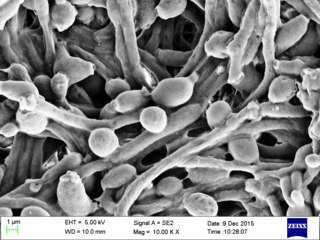
Candida albicans is an opportunistic pathogenic yeast that is a common member of the human gut flora. It can also survive outside the human body. It is detected in the gastrointestinal tract and mouth in 40–60% of healthy adults. It is usually a commensal organism, but it can become pathogenic in immunocompromised individuals under a variety of conditions. It is one of the few species of the genus Candida that cause the human infection candidiasis, which results from an overgrowth of the fungus. Candidiasis is, for example, often observed in HIV-infected patients. C. albicans is the most common fungal species isolated from biofilms either formed on (permanent) implanted medical devices or on human tissue. C. albicans, C. tropicalis, C. parapsilosis, and C. glabrata are together responsible for 50–90% of all cases of candidiasis in humans. A mortality rate of 40% has been reported for patients with systemic candidiasis due to C. albicans. By one estimate, invasive candidiasis contracted in a hospital causes 2,800 to 11,200 deaths yearly in the US. Nevertheless, these numbers may not truly reflect the true extent of damage this organism causes, given new studies indicating that C. albicans can cross the blood–brain barrier in mice.

Candida is a genus of yeasts. It is the most common cause of fungal infections worldwide and the largest genus of medically important yeasts.

Oral candidiasis (Acute pseudomembranous candidiasis), also known as oral thrush among other names, is candidiasis that occurs in the mouth. That is, oral candidiasis is a mycosis (yeast/fungal infection) of Candida species on the mucous membranes of the mouth.

The corpus albicans is the regressed form of the corpus luteum. As the corpus luteum is being broken down by macrophages, fibroblasts lay down type I collagen, forming the corpus albicans. This process is called "luteolysis". The remains of the corpus albicans may persist as a scar on the surface of the ovary.

A chlamydospore is the thick-walled large resting spore of several kinds of fungi, including Ascomycota such as Candida, Basidiomycota such as Panus, and various Mortierellales species. It is the life-stage which survives in unfavourable conditions, such as dry or hot seasons. Fusarium oxysporum which causes the plant disease Fusarium wilt is one which forms chlamydospores in response to stresses like nutrient depletion. Mycelia of the pathogen can survive in this manner and germinate in favorable conditions.
Undecylenic acid is an organic compound with the formula CH2=CH(CH2)8CO2H. It is an unsaturated fatty acid. It is a colorless oil. Undecylenic acid is mainly used for the production of Nylon-11 and in the treatment of fungal infections of the skin, but it is also a precursor in the manufacture of many pharmaceuticals, personal hygiene products, cosmetics, and perfumes. Salts and esters of undecylenic acid are known as undecylenates.
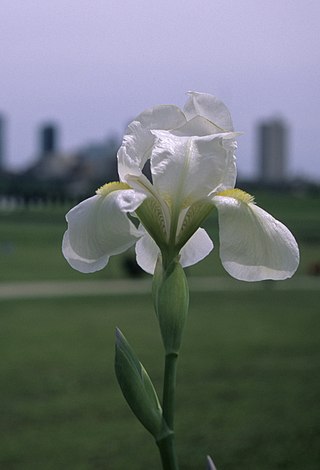
Iris albicans, also known as the cemetery iris, white cemetery iris, or the white flag iris, is a species of iris which was planted on graves in Muslim regions and grows in many countries throughout the Middle East and northern Africa. It was later introduced to Spain, and then other European countries. It is a natural hybrid.

Dimorphic fungi are fungi that can exist in the form of both mold and yeast. This is usually brought about by change in temperature and the fungi are also described as thermally dimorphic fungi. An example is Talaromyces marneffei, a human pathogen that grows as a mold at room temperature, and as a yeast at human body temperature.
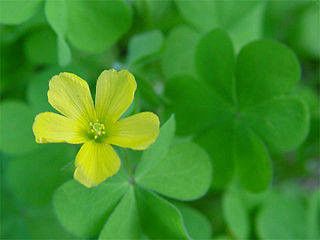
Oxalis albicans, commonly known as radishroot woodsorrel, is North American species of perennial herbs in the woodsorrel family. It is widespread in Mexico and the southwestern United States.

Gyrtona is a genus of moths of the family Euteliidae first described by Francis Walker in 1863.
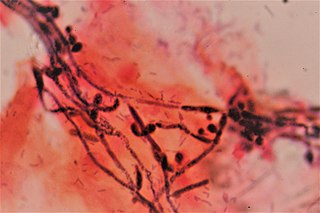
Vaginal yeast infection, also known as candidal vulvovaginitis and vaginal thrush, is excessive growth of yeast in the vagina that results in irritation. The most common symptom is vaginal itching, which may be severe. Other symptoms include burning with urination, a thick, white vaginal discharge that typically does not smell bad, pain during sex, and redness around the vagina. Symptoms often worsen just before a woman's period.
Gyrtona polionota is a moth of the family Euteliidae. It is found in Fiji, New Guinea and Australia.
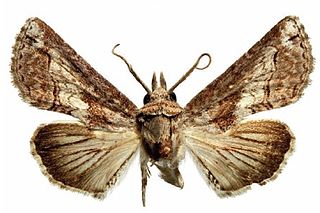
Euteliidae is a family of moths in the superfamily Noctuoidea. The family was erected by Augustus Radcliffe Grote in 1882.
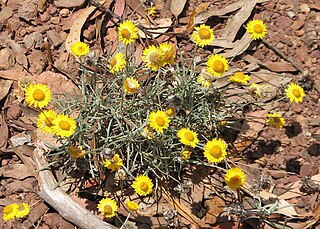
Leucochrysum albicans, commonly known as hoary sunray, is a flowering plant in the family Asteraceae. It is a small perennial with grey leaves, white or yellow flower-heads and is endemic to Australia.
Denture-related stomatitis is a common condition where mild inflammation and redness of the oral mucous membrane occurs beneath a denture. In about 90% of cases, Candida species are involved, which are normally a harmless component of the oral microbiota in many people. Denture-related stomatitis is the most common form of oral candidiasis. It is more common in elderly people, and in those who wear a complete upper denture. Denture-related stomatitis is more likely to develop when the denture is left constantly in the mouth, rather than removing it during sleep, and when the denture is not cleaned regularly.
Gyrtona malgassica is a moth of the family Euteliidae first described by George Hamilton Kenrick in 1917. It is found on Madagascar.
Gyrtona purpurea is a moth of the family Euteliidae. It was described by Robinson in 1975. It is found on Fiji.

Kaustuv Sanyal is an Indian molecular biologist, mycologist and a professor at the Molecular Biology and Genetics Unit of the Jawaharlal Nehru Centre for Advanced Scientific Research (JNCASR). He is known for his molecular and genetic studies of pathogenic yeasts such as Candida and Cryptococcus). An alumnus of Bidhan Chandra Krishi Viswavidyalaya and Madurai Kamaraj University from where he earned a BSc in agriculture and MSc in biotechnology respectively, Sanyal did his doctoral studies at Bose Institute to secure a PhD in Yeast genetics. He moved to the University of California, Santa Barbara, USA to work in the laboratory of John Carbon on the discovery of centromeres in Candida albicans. He joined JNCASR in 2005. He is a member of the Faculty of 1000 in the disciplines of Microbial Evolution and Genomics and has delivered invited speeches which include the Gordon Research Conference, EMBO conferences on comparative genomics and kinetochores. The Department of Biotechnology of the Government of India awarded him the National Bioscience Award for Career Development, one of the highest Indian science awards, for his contributions to biosciences, in 2012. He has also been awarded with the prestigious Tata Innovation Fellowship in 2017. The National Academy of Sciences, India elected him as a fellow in 2014. He is also an elected fellow of Indian Academy of Sciences (2017), and the Indian National Science Academy (2018). In 2019, he has been elected to Fellowship in the American Academy of Microbiology (AAM), the honorific leadership group within the American Society for Microbiology.
Gyrtona hylusalis is a moth of the family Euteliidae.
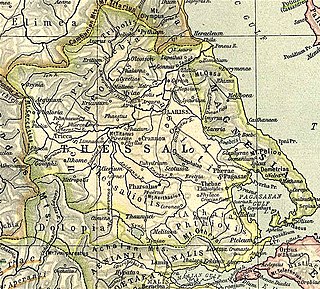
Gyrton or Gyrtona or Gyrtone (Γυρτώνη) was a town and polis (city-state) of Perrhaebia in ancient Thessaly, situated in a fertile plain between the rivers Titaresius and Peneius. Strabo connects Gyrton with the mouth of the Peneius; but it is evident from the description of Livy, whose account has been derived from Polybius, that it stood in some part of those plains in which Phalanna, Atrax, and Larissa were situated. It was only one day's march from Phalanna to Gyrton. It was an ancient town even in Classical times, mentioned by Homer, and continued to be a place of importance till later times, when it is called opulent by Apollonius Rhodius. It was said to have been the original abode of the Phlegyae, and to have been founded by Gyrton, the brother of Phlegyas. Others say that it derived its name from Gyrtone, who is called a daughter of Phlegyas.














